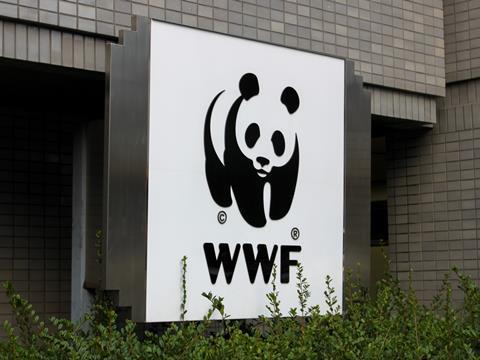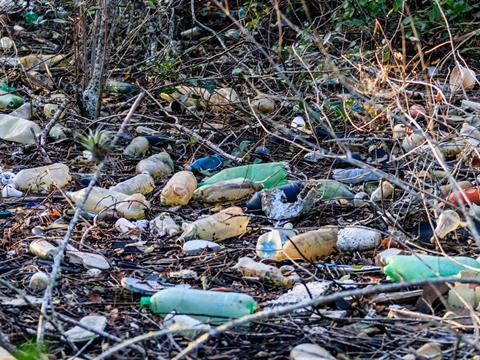
A new position paper by WWF has set out a framework for the scaling of sustainable reuse systems for plastic packaging – a transition that it claims will reduce emissions, create new jobs, and open up financial opportunities for smaller businesses.
According to the UN Environment Programme, plastic production has quadrupled in the past forty years, and is expected by the World Economic Forum to quadruple again by 2050. While it is thought that the solutions necessary for reducing plastic leakage into the ocean by 80% by 2040 are already available, PEW suggests that current governmental and industrial commitments, if followed through, would only result in a 7% reduction. As such, WWF argues that an international system of ‘ambitious strategies’ must be adopted to prevent the amount of plastic waste entering the oceans from tripling by 2040.
The paper points out that reducing plastic waste should be the ultimate focus in the pursuit of sustainable packaging; that reuse systems should always complement other reduction strategies, which include cutting down on unnecessary packaging and entirely phasing out single-use plastics where possible. As such, it considers reusables to be second place in the ‘waste management hierarchy’.
Nevertheless, it identifies reusables as a useful means of managing the use and optimising the life of material resources, as well as reducing the amount of waste entering disposal systems. Effective scaling is thought to provide reusable systems with the means to cut down on material and emission footprints in comparison to single-use packaging, as well as decreasing its likelihood of being littered.
Reuse systems are also capable of reducing greenhouse gas emissions from the production of virgin plastics, it is claimed. Therefore, they drive down rates of plastic pollution and enable consumers to change their behaviour to reduce their own environmental footprints.

According to WWF, scaling up European reuse systems by 20% by 2027 would save 1.3 million tonnes of emissions, almost 2.5 billion cubic metres of water, and 10 million tonnes of materials every year. At 50% by 2030, these figures would rise to 3.7 million tonnes of emissions, 10 billion cubic metres of water, and 23 million tonnes of materials in Europe alone.
In the near-term, subscription models for the repeated re-purchasing of the same product by the same individual are highlighted as one example of an application that lends itself to reusable packaging. However, WWF encourages companies dealing in fast-moving consumer goods to aim for 30% reuse by 2030, should they be able to provide evidence that this transition would have a reduced impact in comparison to single-use packaging.
A wide-scale transition into reusable systems is also thought to be financially lucrative. Citing the Ellen MacArthur Foundation, the paper states that replacing 20% of single-use plastic packaging with reusable solutions would result in a $10 billion business opportunity.
Value is thought to be spread across a product’s life cycle rather than being limited to the extraction and manufacturing stages as in single-use packaging; 95% of the value of single-use solutions is thought to be lost when it is disposed of after one use.
Therefore, reusables are expected to benefit entrepreneurs, as well as local businesses and workforces by making space for them in the industry and keeping the value of packaging circulating through the economy.
On the other hand, it is noted that current reuse solutions have high entry costs, which restricts some businesses from participating in reuse strategies. WWF states that companies and policymakers must work on new solutions to ensure that reuse schemes are accessible and financially sensible for businesses and consumers, and to overcome any remaining economic and environmental shortcomings in relation to reuse schemes.
Because of the need for reusable packaging to be durable throughout transportation, use, repair, and cleaning, it is often heavier and contains more material than single-use packaging. These features must be balanced with ‘impacts from sourcing, manufacturing, and end-of-life management, the paper asserts.
Reusables should aim to achieve a “breakeven” point, wherein its number of possible uses allows it to perform better than single-use alternatives – thus making its environmental footprint lower as the number of uses increases and the resources required to manufacture the packaging decreases. Such tracking technologies as QR codes and blockchain are said to allow for the tracking of packaging within reuse systems to ensure it reaches its maximum usage.
WWF also insists that reuse systems should be continually assessed to ensure that they are fully effective. If they fail to function effectively within their reuse scheme, they ‘run the risk of essentially serving as heavier, more resource-intensive single-use packaging’. Material waste, greenhouse gas emissions, energy and water use, and other environmental metrics are also highlighted as points of consideration during the evaluation process.

Challenges to reuse are thought to vary between countries and hemispheres. The Global North, for instance, is said to require a stronger drive towards universal company action and concrete policies, increased funding into research and development, and new solutions to reverse logistics on an industrial level for reuse systems to be implemented at scale. Consumer behaviour must change to accommodate the new system, and both the packaging itself and the education necessary to utilise it should be affordable and accessible, the paper argues.
Zero Waste Europe highlights existing, small-scale reuse systems in the Global South, including the collection of used glass bottles at local shops and stores, systems, and companies dedicated to reuse. In many cases, these systems have arisen where single-use solutions would be more expensive to execute. Greenpeace adds that some countries have already passed legislation to create an environment wherein single-use packaging can be phased out and replaced with reusables.
WWF is pushing for such systems to implemented globally to combat the social, economic, and environmental effects of linear, single-use solutions. Regular and effective waste collection services, and disposal methods that do not come at the expense of local communities or the planet, must be implemented in every country.
To ensure that such scaling is successful, the company claims that reuse systems should provide economic stability and economic sustainability for continued revenue growth. Social and economic benefits can reportedly be gained from reuse efforts that prioritise access and solve multiple problems at once; for instance, scaling reverse logistics for reuse can go hand-in-hand with improving waste management access at a local level.
Achieving cost parity between single-use packaging and reusables is thought to encourage businesses to implement reusable packaging and drive market value in doing so. In turn, providing efficient systems with an enabling policy landscape will incentivise companies to keep investing in and scaling their programmes as consumers continue to buy reusable packaging.
WWF also states that reuse goals should be underpinned by health and safety regulations and evidence gathered via assessments. They should provide educational programmes and communication plans to allow for local reuse schemes, which may be funded by Extender Producer Responsibility (EPR) programmes or by taxing single-use packaging.
The paper asserts that reuse goals should be implemented as part of national action plans to reduce plastic waste and identifies cities as an optimal location to begin scaling reuse schemes. This is due to their high populations and dense consumer markets. The systems implemented there must be convenient and accessible, says WWF, and the process of refilling and returning packaging must be incentivised for customers.

It is also thought that city leadership has the power and outreach to encourage behavioural changes amongst a diverse range of citizens. However, some locations are expected to require changes to national and international policies before reuse schemes will be fully effective.
Although a full implementation of reusable packaging is expected to have a specific impact on the waste-picking profession, it is also anticipated to create jobs across the supply chain – including the manufacturing, distribution, collection, cleaning, and redistribution of packaging – that will supplement the loss. The paper suggests that current waste pickers can be retrained to work in any of these areas.
If reuse systems are fully optimised, Upstream indicates that packaging can be reused over 200 times, and up to 1,000 for durable materials such as steel, ceramic, and glass. Indeed, while this paper’s focus is limited to plastic reusables, those made of other materials are thought to have similar social, economic, and environmental outcomes, and WWF states that plastics should become one option in a variety of reusable materials available at scale.
Even so, to achieve an 80% reduction in ocean-bound plastics, the adoption of reuse must apparently cover at least one-third of the total reduction in projected plastic waste generation. The company therefore calls upon actors in private sectors, policymakers, academics, NGO experts, and other value chain players to collaborate in the immediate scaling of reuse systems.
It also points out the importance of a credible accounting system. This is thought to ensure that the environmental benefits of reuse systems are measured, providing the data to justify their utilisation over single-use packaging.
Their contribution to companies’ footprint should also be measured fairly, consistently, and transparently for the sake of comparison with single-use packaging and with other companies, as well as keeping track of improvement over time.
The report concludes that everyone, from business owners to consumers, should contribute towards more sustainable and accessible packaging systems and “reverse the underlying philosophy of the throwaway culture that has been dominant for decades”. WWF points to Consumers Beyond Waste’s three sets of guidelines as a framework for designers and practitioners to use in order to achieve success in their reuse schemes.
Another recent report by McKinsey identified four ‘enablers’ to ensure the successful scaling of reusable and refillable packaging solutions – lowered cost, process harmonisation, expansion of framework beyond a national level, and the meeting of format and hygiene requirements. Like WWF, it underlines cooperation as an essential tool in achieving the complete normalisation of reusable packaging.
That being said, the Ellen MacArthur Foundation is not optimistic that its Global Commitment signatories will meet their goal of 100% recyclable, reusable, refillable or compostable packaging by 2025. The share of plastic packaging used by the companies that is also reusable has reportedly decreased to an average of 1.2%.
FEFCO has also encouraged European policymakers to consider the complexity of reusable plastic’s sustainability claims and consider reuse on a case-by-case basis. Single-use cardboard was said to have a lower environmental impact in an analysis conducted by Ramboll and VTT, thus reiterating the need for multiple systems in pursuit of sustainability.












No comments yet